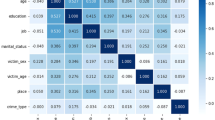Abstract
Crime is a universal social issue that affects a society’s nature of life and economic growth. With ever-increasing crime rates, law enforcement agencies have begun to show interest in data mining approaches to analyze crime patterns in an effort to protect their communities. Existing work in crime prediction is carried out by clustering the attributes into a set of crime categories. This paper is taking the classification approach to predict crime category by building and comparing the performance of two classifiers; Random Forest and Support Vector Machine. The classification model is built using the UCI Crime and Communities dataset that consists of demographic information and other attributes. The results have shown that Random Forest has outperformed the Support Vector Machine in classifying the crimes with an accuracy of 99.9% due to the mixed nature of numerical and categorical features in the datasets.
Access this chapter
Tax calculation will be finalised at checkout
Purchases are for personal use only
Similar content being viewed by others
References
Bennett, P.: The heterogeneous effects of education on crime: evidence from Danish administrative twin data. Labour Econ. 52, 160–177 (2018)
Sathyadevan, S., Gangadharan, S.: Crime analysis and prediction using data mining. In: 2014 First International Conference on Networks & Soft Computing (ICNSC), pp. 406–412. IEEE, August 2014
Malathi, A., Baboo, S.S.: An enhanced algorithm to predict a future crime using data mining (2011)
Mostafa, S.A., et al.: Examining multiple feature evaluation and classification methods for improving the diagnosis of Parkinson’s disease. Cogn. Syst. Res. 54, 90–99 (2019)
Iqbal, R., Murad, M.A.A., Mustapha, A., Panahy, P.H.S., Khanahmadliravi, N.: An experimental study of classification algorithms for crime prediction. Indian J. Sci. Technol. 6(3), 4219–4225 (2013)
Chandrasekar, A., Raj, A.S., Kumar, P.: Crime Prediction and Classification in San Francisco City (2015). http://cs229.stanford.edu/proj2015/228_report.pdf
Yadav, S., Timbadia, M., Yadav, A., Vishwakarma, R., Yadav, N.: Crime pattern detection, analysis & prediction. In: 2017 International conference of Electronics, Communication and Aerospace Technology (ICECA), vol. 1, pp. 225–230. IEEE, April 2017
Wijenayake, S., Graham, T., Christen, P.: A decision tree approach to predicting recidivism in domestic violence. arXiv preprint arXiv:1803.09862 (2018)
Wirth, R., Hipp, J.: CRISP-DM: towards a standard process model for data mining. In: Proceedings of the 4th International Conference on the Practical Applications of Knowledge Discovery and Data Mining, pp. 29–39. Citeseer, April 2000
Kalmegh, S.: Analysis of Weka data mining algorithm REPTree, simple cart and RandomTree for classification of Indian news. Int. J. Innov. Sci. Eng. Technol. 2(2), 438–446 (2015)
Kalmegh, S.R.: Comparative analysis of WEKA data mining algorithm RandomForest, RandomTree and LADTree for classification of indigenous news data. Int. J. Emerg. Technol. Adv. Eng. 5(1), 507–517 (2015)
Mostafa, S.A., Mustapha, A., Khaleefah, S.H., Ahmad, M.S., Mohammed, M.A.: Evaluating the performance of three classification methods in diagnosis of Parkinson’s disease. In: Ghazali, R., Deris, M., Nawi, N., Abawajy, J. (eds.) SCDM 2018. AISC, vol. 700, pp. 43–52. Springer, Cham (2018). https://doi.org/10.1007/978-3-319-72550-5_5
Mostafa, S.A., Mustapha, A., Mohammed, M.A., Ahmad, M.S., Mahmoud, M.A.: A fuzzy logic control in adjustable autonomy of a multi-agent system for an automated elderly movement monitoring application. Int. J. Med. Inform. 112, 173–184 (2018)
Gupta, A., Mohammad, A., Syed, A., Halgamuge, M.N.: A comparative study of classification algorithms using data mining: crime and accidents in Denver City the USA. Education 7(7), 374–381 (2016)
Arunkumar, N., Mohammed, M.A., Mostafa, S.A., Ibrahim, D.A., Rodrigues, J.J., de Albuquerque, V.H.C.: Fully automatic model‐based segmentation and classification approach for MRI brain tumor using artificial neural networks. Concurr. Comput. Pract. Exp. e4962 (2018)
Hassan, M.H., Mostafa, S.A., Mustapha, A., Wahab, M.H.A., Nor, D.M.: A survey of multi-agent system approach in risk assessment. In: 2018 International Symposium on Agent, Multi-Agent Systems and Robotics (ISAMSR), pp. 1–6. IEEE, August 2018
Khaleefah, S.H., Mostafa, S.A., Mustapha, A., Darman, R.: A general framework of multi-agent features extraction operators for deformed images identification. In: 2018 International Symposium on Agent, Multi-Agent Systems and Robotics (ISAMSR), pp. 1–5. IEEE, August 2018
Rodriguez, J.D., Perez, A., Lozano, J.A.: Sensitivity analysis of k-fold cross validation in prediction error estimation. IEEE Trans. Pattern Anal. Mach. Intell. 32(3), 569–575 (2010)
Khalaf, B.A., Mostafa, S.A., Mustapha, A., Mohammed, M.A., Abduallah, W.M.: Comprehensive review of artificial intelligence and statistical approaches in distributed denial of service attack and defense methods. IEEE Access 7, 51691–51713 (2019)
Al Amrani, Y., Lazaar, M., El Kadiri, K.E.: Random forest and support vector machine based hybrid approach to sentiment analysis. Proc. Comput. Sci. 127, 511–520 (2018)
Acknowledgement
This research is supported by Universiti Tun Hussein Onn Malaysia.
Author information
Authors and Affiliations
Corresponding author
Editor information
Editors and Affiliations
Rights and permissions
Copyright information
© 2020 Springer Nature Switzerland AG
About this paper
Cite this paper
Zaidi, N.A.S., Mustapha, A., Mostafa, S.A., Razali, M.N. (2020). A Classification Approach for Crime Prediction. In: Khalaf, M., Al-Jumeily, D., Lisitsa, A. (eds) Applied Computing to Support Industry: Innovation and Technology. ACRIT 2019. Communications in Computer and Information Science, vol 1174. Springer, Cham. https://doi.org/10.1007/978-3-030-38752-5_6
Download citation
DOI: https://doi.org/10.1007/978-3-030-38752-5_6
Published:
Publisher Name: Springer, Cham
Print ISBN: 978-3-030-38751-8
Online ISBN: 978-3-030-38752-5
eBook Packages: Computer ScienceComputer Science (R0)




